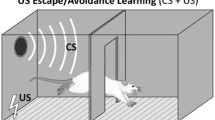Abstract
Two Warsaw medical students, Jerzy Konorski and Stefan Miller, having read I. P. Pavlov’s works on conditional reflexes, informed him in a 1928 letter that they had discovered a new type of conditioning. A previously neutral stimulus preceded the passive lifting of a dog’s paw which then was followed by feeding; this stimulus then evoked the spontaneous raising of that paw. Pavlov responded informing them that their conditioning of motor responses expanded his theory of higher nervous activity, but that their conditioning paradigm—that they named CRII—did not differ fundamentally from the Pavlovian conditioning paradigm. The replication of the Warsaw experiment in Pavlov’s laboratory failed to provide unequivocal results. From 1931 to 1933, Konorski, working in Pavlov’s Leningrad laboratory, further explored the parameters of CRII. Pavlov insisted that the conditioning of motor movements differs from the conditioning of other sensory analyzers only in that, on the neural level, the motor analyzer is both afferent, that is, perceptive, and efferent, that is, responsive. Konorski was not convinced, and he subsequently maintained that the two conditioning paradigms were fundamentally different.
Similar content being viewed by others
References
Konorski, J. (1968).Conditioned reflexes and neuron organization. New York, London: Hafner Publishing. (Original work published in 1948.)
Konorski, J. (1974). In G. Lindzey (Ed.), Jerzy Konorski.A history of psychology in autobiography, Vol. 6 (pp. 185–217). Englewood Cliffs, NJ: Prentice-Hall.
Konorskii, Iu., & Miller, S. (1936). Uslovnye refleksy dvigateltnogo analizatora [The conditional reflexes of the motor analyzer].Trudy Fiziologicheskikh Laboratorii Akad. I. P. Pavlova, 6(1), 119–278, 285–288.
Krasnogorskii, N. I. (1911).O protsesse zaderzhivaniia i o lokalizatsii kozhnaqo i dvigatel’naqo analizatorov v kore bol’shikh polusharii u sobaki [On the processes of inhibition and localization of the tactile and motor analyzers in the cortex of the large hemispheres in a dog]. St. Petersburg: Tipografiia Glavnago Upravleniia Udelov.
Kreps, E. M. (1970a) (Ed.). Iu. Konorskii i S. Miller—I. P. Pavlovu. Letter No. 302. InPerepiska I. P. Pavlova. Leningrad: Izdatel’stvo “Nauka.”
Kreps, E. M. (1970b) (Ed.). I. P. Pavlov—Iu. Konorskomu i S. Milleru. Letter No. 303. InPerepiska I. P. Pavlova. Leningrad: Izdatel’stvo “Nauka.”
Maiorov, F. P. (1954).Istoriia ucheniia ob uslovnykh refleksakh [The history of the teachings on conditional reflexes]. Moscow, Leningrad: Izdatel’stvo Akademii Nauk SSSR.
Pavlov, I. P. (1949a).Pavlovskie sredy; protokoly i stenogramy fiziologicheskikh besed [Pavlovian Wednesdays; protocols and stenographs of physiological seminars]. Vol. 1. Moscow, Leningrad: Izdatel’stvo Akademii Nauk SSSR.
Pavlov, I. P. (1949b).Pavlovskie sredy; protokoly i stenoqramy fiziologicheskikh besed [Pavlovian Wednesdays; protocols and stenographs of physiological seminars]. Vol. 2. Moscow, Leningrad: Izdatel’stvo Akademii Nauk SSSR.
Pavlov, I. P. (1951a). Dvadtsatiletnii opyt ob’ektivnogo izucheniia vysshei nervnoi deiatel’nosti povedeniia zhivotnykh [Twenty years of the objective studies of higher nervous activity behavior of animals]. InI. P. Pavlov, polnoe sobranie sochinenii. (Vol. 3, Part 1). Moscow, Leningrad: Izdatel’stvo Akademii Nauk SSSR. (Original work published in 1923.)
Pavlov, I. P. (1951b). Lektsii o rabote bol’shikh polusharii golovnogo mozga [Lectures on the function of cerebral hemispheres]. InI. P. Pavlov, polnoe sobranie sochinenii. (Vol. 4, 2nd enlarged ed.). Moscow, Leningrad: Izdatel’stvo Akademii Nauk SSSR. (Original work published in 1924.)
Pavlov, I. P. (1951c). Uslovnyi refleks [The conditional reflex]. InI. P. Pavlov, polnoe sobranie sochinenii. (Vol. 3, Part 2, 2nd enlarged ed.), (pp. 320–343). Moscow, Leningrad: Izdatel’stvo Akademii Nauk SSSR.
Petrova, M. K. (1941). Materialy k poznanilu fiziologicheskogo mekhanizma proizvol’nykh dvizhenii [Materials toward the understanding of the physiological mechanism of voluntary movements].Trudy Fiziologicheskikh Laboratorii Akad. I. P. Pavlova, 10, 41–50.
Podkopaev, N. A. (1940). Vyrabotka uslovnogo tormoza iz propriotseptivnogo razdrazhitelia [The formation of the conditional inhibition from the proprioceptive stimulus].Trudy Fiziologicheskikh Laboratorii Akad. I. P. Pavlova, 9, 400–404.
Skipin, G. V. (1941a). Analiz vysshei nervnoi delatel’nosti sobaki po uslozhnennoi sekretornodvigatel’noi metodike. Soobshchenie pervoe [The analysis of the higher nervous activity in a dog by the complex secretive-motor method. First report]Trudy Fiziologicheskikh Laboratorii Akad. I. P. Pavlova, 10, 5–16.
Skipin, G. V. (1941b). Analiz vysshei nervnoi deiatel’nosti sobaki po uslozhnennol sekretornodvigatel’noi metodike. Soobshchenie vtoroe [The analysis of the higher nervous activity in a dog by the complex secretive-motor method. Second report].Trudy Fiziologicheskikh Laboratorii Akad. I. P. Pavlova, 10, 17–24.
Wyrwicka, W. (1994). Jerzy Konorski (1903–1973) on the 20th anniversary of his death.Neuroscience and Biobehavioral Reviews, 18, 449–453.
Author information
Authors and Affiliations
Rights and permissions
About this article
Cite this article
Windholz, G., Wyrwicka, W. Pavlov’s position toward konorski and miller’s distinction between pavlovian and motor conditioning paradigms. Integrative Physiological and Behavioral Science 31, 338–349 (1996). https://doi.org/10.1007/BF02691437
Issue Date:
DOI: https://doi.org/10.1007/BF02691437




